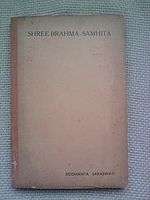Brahma Samhita
The Brahma Saṁhitā is a Sanskrit Pañcarātra text, composed of verses of prayer spoken by Brahma glorifying the Supreme Lord Kṛṣṇa or Govinda at the beginning of creation. It is revered within Gauḍiya Vaiṣṇavism, whose 16th-century founder, Caitanya Mahāprabhu (1486–1534), rediscovered a part of the work, the 62 verses of Chapter 5, which had previously been lost for a few centuries, at the Adikeshav Temple in Thiruvattar, Tamil Nadu, South India.[1] Mitsunori Matsubara, in his Pañcarātra Saṁhitās and Early Vaisṇava Theology dates the text at c. 1300 CE. The text contains a highly esoteric description, with the Kāma-Gāyatrī, of Kṛṣṇa in His abode Goloka.

In 1970, George Harrison produced a modern recording of these prayers performed by devotees of the Rādha Kṛṣṇa Temple in London. Titled "Govinda", the song took its title from the main chorus line of the prayer "govindam ādi-puruṣam tam ahaṁ bhajāmi", meaning "I worship Govinda, the primeval Lord". This prayer was sung by Yamunā Devi, a disciple of A.C. Bhaktivedanta Swami Prabhupāda.
Recovered text
The recovered fragment of the Śrī Brahma-samhitā commences at the fifth chapter, whose first verse states:
īśvaraḥ paramaḥ kṛṣṇaḥ sac-cid-ānanda-vigrahaḥ
anādir ādir govindaḥ sarva kāraṇa kāraṇam
This translates to:
The text was first translated from Sanskrit into English by Bhakti Siddhānta Sarasvatī Ṭhākura in 1932 and is often sung or recited as both a devotional and philosophical text.
References
- A history of the Brahma Saṁhitā, Feb 17, 2012, (Indiadivine.org)
- http://www.vedabase.com/en/bs/5/1
Further reading
- Bhaktisiddhanta Sarasvati, Goswami, (trans.), Sri Brahma-Samhita, with commentary by Srila Jiva Goswami, Sri Gaudiya Math 1932, reprint The Bhaktivedanta Book Trust, Los Angeles, 1985.
- Matsubara, Mitsunori, Pancaratra Samhitas and Early Vaisnava Theology, Motilal Banarsidass, New Delhi, 1994.
- Narayana, Bhaktivedanta, Swami, (trans.), Sri Brahma Samhita, Fifth Chapter, with the full commentary by Srila Jiva Goswami, Gaudiya Vedanta Publications, Vrindavana UP, 2003.
- Otto Schrader, F., Introduction to the Pañcarātra and the Ahirbudhnya Saṁhitā, Adyar Library, Madras 1916. Second edition 1973.
- Sagar, B.A., Tridandi Bhiksu, (trans.), Śrī Brahma Saṁhitā, Quintessence of Reality the Beautiful, with the commentary by Srila Bhaktivinoda Thakur, Sri Chaitanya Saraswat Math, Nabadwip 1992.